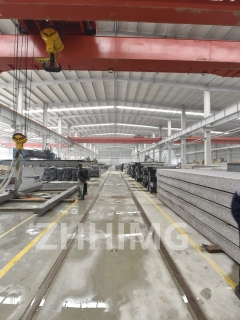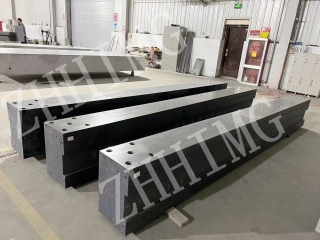In CNC numerical control equipment, although granite has become an important material due to its unique properties, its inherent drawbacks may also have certain impacts on equipment performance, processing efficiency and maintenance costs. The following is an analysis of the specific impacts brought by the shortcomings of granite from multiple dimensions:
First, the material is highly brittle and prone to breakage and damage
Core drawback: Granite is a natural stone and is essentially a brittle material with poor impact toughness (the impact toughness value is approximately 1-3J/cm², which is much lower than the 20-100J/cm² of metallic materials).

Impact on CNC equipment:
Installation and transportation risks: During the assembly or handling of the equipment, if it is subjected to collision or drop, granite components (such as bases and guide rails) are prone to cracks or chipped corners, leading to accuracy failure. For instance, if the granite platform of a three-coordinate measuring machine develops hidden cracks due to improper operation during installation, it may lead to a gradual deterioration of flatness over long-term use, affecting the measurement results.
Hidden dangers in the processing process: When CNC equipment encounters sudden overload (such as the tool colliding with the workpiece), the granite guide rails or worktables may break due to the inability to withstand the instantaneous impact force, causing the equipment to shut down for maintenance, and even triggering a chain of precision failures.
Second, the high processing difficulty restricts the design of complex structures
Core drawbacks: Granite has a high hardness (6-7 on the Mohs scale), and it needs to be ground and processed with special tools such as diamond grinding wheels, resulting in low processing efficiency (milling efficiency is only 1/5 to 1/3 of that of metal materials), and the cost of processing complex curved surfaces is high.
Impact on CNC equipment:
Structural design limitations: To avoid processing difficulties, granite components are usually designed in simple geometric shapes (such as plates, rectangular guide rails), making it difficult to achieve complex inner cavities, lightweight stiffened plates and other structures that can be accomplished by casting/cutting with metal materials. This leads to the fact that the weight of the granite base is often too large (10%-20% heavier than cast iron for the same volume), which may increase the overall load of the equipment and affect the dynamic response performance during high-speed movement.
High maintenance and replacement costs: When local wear or damage occurs to granite components, it is difficult to repair them through methods such as welding or cutting. Usually, the entire component needs to be replaced, and the new components need to be re-ground and calibrated for accuracy, resulting in prolonged downtime (a single replacement may take 2-3 weeks), and a significant increase in maintenance costs.
Iii. Uncertainty of Natural Textures and Internal Defects
Core drawback: As a natural mineral, granite has uncontrollable internal fissures, pores or mineral impurities, and the material uniformity of different veins varies greatly (density fluctuation can reach ±5%, elastic modulus fluctuation ±8%).
Impact on CNC equipment:
Precision stability risk: If the processing area of the component happens to contain internal cracks, during long-term use, the cracks may expand due to stress, causing local deformation and affecting the accuracy of the equipment. For instance, if the granite guide rails of a CNC grinding machine have hidden air holes, they may gradually collapse under high-frequency vibration, resulting in excessive straightness error of the guide rails.
Batch performance differences: Granite materials from different batches may experience fluctuations in key indicators such as the coefficient of thermal expansion and damping performance due to differences in mineral composition, which affects the consistency of batch production by equipment. For automated production lines that require the interaction of multiple devices, such differences may lead to an increase in the dispersion of processing accuracy.
Fourth, it is heavy, which affects the dynamic performance of the equipment
Core drawback: Granite has a high density (2.6-3.0g/cm³), and its weight is approximately 1.2 times that of cast iron and 2.5 times that of aluminum alloy under the same volume.
Impact on CNC equipment:
Motion response lag: In high-speed machining centers or five-axis machines, the large mass of the granite base will increase the load inertia of the linear motor/lead screw, resulting in dynamic response delay during acceleration/deceleration (which may increase the start-stop time by 5% to 10%), affecting the processing efficiency.
Increased energy consumption: Driving heavy granite components requires more powerful servo motors, which raises the overall energy consumption of the equipment (actual measurements show that under the same working conditions, the energy consumption of granite base equipment is 8%-12% higher than that of cast iron equipment). Long-term use will increase production costs.
Five, the ability to resist thermal shock is limited
Core drawback: Although granite has a low coefficient of thermal expansion, its thermal conductivity is poor (with a thermal conductivity of only 1.5-3.0W/(m · K), approximately 1/10 that of cast iron), and sudden local temperature changes are prone to generating thermal stress.
Impact on CNC equipment:
Temperature difference issue in processing area: If the cutting fluid concentratatively erodes a local area of the granite worktable, it may cause a temperature gradient (such as a temperature difference of 5-10℃) between this area and the surrounding area, leading to minor thermal deformation (deformation amount can reach 1-3μm), which affects the accuracy consistency of precision processing (such as micron-level gear grinding).
Long-term thermal fatigue risk: In workshop environments with frequent start-ups and shutdowns or large temperature differences between day and night, granite components may develop microcracks due to repeated thermal expansion and contraction, gradually weakening the structural rigidity.
Post time: May-24-2025

